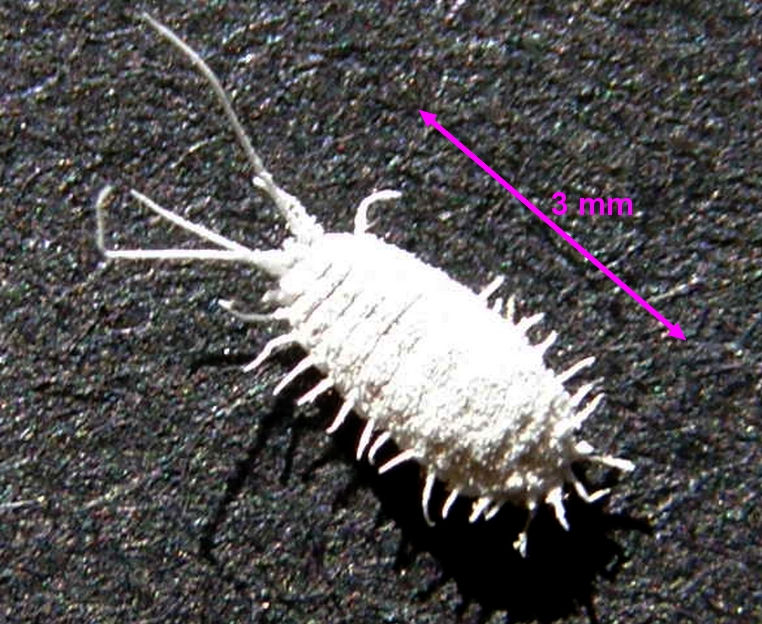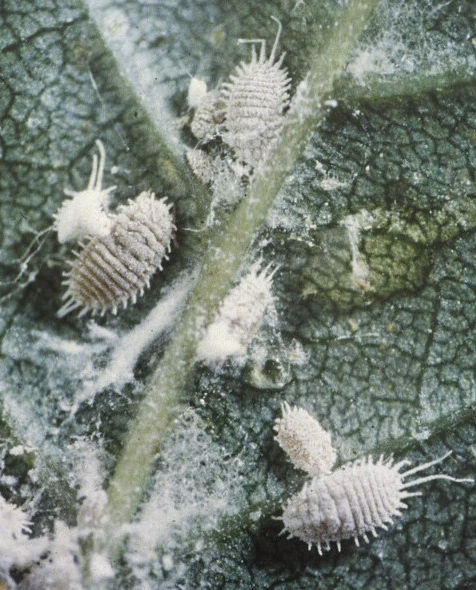- Home
- Garden Wildlife
- Insects
- Hemiptera
- Mealy bugs
Mealybugs
Mealybugs are sap-sucking insects in the family Pseudococcidae of the order Hemiptera. They are closely related to scale insects but lack a waxy covering shell over their bodies. Most mealybugs are soft-bodied greyish-white insects up to 2-4mm in length.
Species in Britain and Ireland
Nearly 50 species of mealybug have been recorded in Britain and Ireland. The native species tend to be found mostly on grasses and are rarely noticed in gardens. There are several non-native species that are pests in greenhouses and on house plants. These include Pseudococcus longispinus, Pseudococcus viburni and Planococcus citri. Some root mealybugs such as Rhizoecus species, can be damaging to pot plants. A New Zealand mealybug, Balanococcus diminutus, can cause dieback on New Zealand flax, Phormium tenax, in gardens.
Adult female Mealybug Pseudococcus viburni. Monophlebulus sp. Australian species showing female
and winged males
Biology
Mealybug females often look a bit like woodlice, with pairs of structures called cerarii on the edges of each body segment. These look superficially like legs, but are stout "hairs" with wax pores which secrete protective wax.
Mealybugs feed by sucking sap from the leaves and stems of plant, with root mealybugs feeding in a similar manner on plant roots. They often conceal themselves and their eggs under a fluffy white waxy secretion. Honeydew is excreted, which makes plants sticky and allows the growth of sooty moulds. Mealybugs are often associated with ants that protect them and feed on the honeydew. Their predators include ladybirds, lacewings and some parasitic wasps.
Reproduction and life cycle
Some pest mealybug species are all female, or only rarely have males. The latter are small conventional-looking winged insects, unlike the wingless females. Glasshouse mealybugs can reproduce throughout the year and will have several generations. The females lay batches of eggs under the cover of white waxy fibres. The immature nymphs are similar in appearance to the adult insect.
Role of mealybugs in gardens
With the exception of the Phormium mealybug, mealybugs are rarely seen on outdoor garden plants. It is on house plants and in greenhouses that this type of insect is most often seen and they can be a problem. Cacti and succulents are particularly prone to infestation but many other plants can also be affected.
.jpg)


Other sources of information
Website
RHS advice on managing mealybugs
Page drafted by Andrew Halstead, reviewed by Andrew Salisbury, edited by Steve Head
Typical group of glasshouse mealybugs, nymphs and adults.
Mealybugs
Mealybugs are sap-sucking insects in the family Pseudococcidae of the order Hemiptera. They are closely related to scale insects but lack a waxy covering shell over their bodies. Most mealybugs are soft-bodied greyish-white insects up to 2-4mm in length.
Species in Britain and Ireland
Nearly 50 species of mealybug have been recorded in Britain and Ireland. The native species tend to be found mostly on grasses and are rarely noticed in gardens. There are several non-native species that are pests in greenhouses and on house plants. These include Pseudococcus longispinus, Pseudococcus viburni and Planococcus citri. Some root mealybugs such as Rhizoecus species, can be damaging to pot plants. A New Zealand mealybug, Balanococcus diminutus, can cause dieback on New Zealand flax, Phormium tenax, in gardens.
.jpg)

Adult female mealybug Monophlebulus sp. Australian species
Pseudococcus viburni s showing female and winged males
Biology
Mealybug females often look a bit like woodlice, with pairs of structures calle cerarii on the edges of each body segment. These look superficially like legs, but are stout "hairs" with wax pores which secrete protective wax.
Mealybugs feed by sucking sap from the leaves and stems of plant, with root mealybugs feeding in a similar manner on plant roots. They often conceal themselves and their eggs under a fluffy white waxy secretion. Honeydew is excreted, which makes plants sticky and allows the growth of sooty moulds. Mealybugs are often associated with ants that protect them and feed on the honeydew. Their predators include ladybirds, lacewings and some parasitic wasps.
Reproduction and life cycle
Some pest mealybug species are all female, or only rarely have males. The latter are small conventional-looking winged insects, unlike the wingless females. Glasshouse mealybugs can reproduce throughout the year and will have several generations. The females lay batches of eggs under the cover of white waxy fibres. The immature nymphs are similar in appearance to the adult insect.
Role of mealybugs in gardens
With the exception of the Phormium mealybug, mealybugs are rarely seen on outdoor garden plants. It is on house plants and in greenhouses that this type of insect is most often seen and they can be a problem. Cacti and succulents are particularly prone to infestation but many other plants can also be affected.
Mealybugs
Mealybugs are sap-sucking insects in the family Pseudococcidae of the order Hemiptera. They are closely related to scale insects but lack a waxy covering shell over their bodies. Most mealybugs are soft-bodied greyish-white insects up to 2-4mm in length.
Species in Britain and Ireland
Nearly 50 species of mealybug have been recorded in Britain and Ireland. The native species tend to be found mostly on grasses and are rarely noticed in gardens. There are several non-native species that are pests in greenhouses and on house plants. These include Pseudococcus longispinus, Pseudococcus viburni and Planococcus citri. Some root mealybugs such as Rhizoecus species, can be damaging to pot plants. A New Zealand mealybug, Balanococcus diminutus, can cause dieback on New Zealand flax, Phormium tenax, in gardens.

Other sources of information
Website
RHS advice on managing mealybugs
Page drafted by Andrew Halstead, reviewed by Andrew Salisbury, edited by Steve Head
Typical group of glasshouse mealybugs, nymphs and adults.












